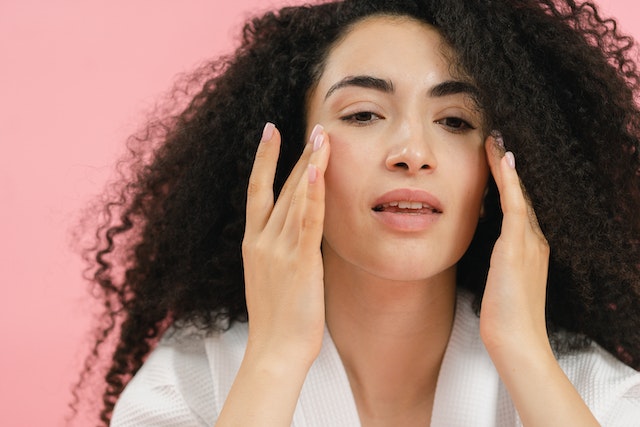It cannot be evident with many products that promise to lighten and brighten. The key is to understand what ingredients are best for your skin.
Skin brightening creams aim to balance out your complexion by fading dark spots brought on by acne scars or sun damage. It is done through a combination of ingredients like:
Vitamin C
A fantastic antioxidant, vitamin C, works as one of the effective skin brighteners. It lessens dark areas by reducing the enzyme that produces melanin, the pigment that gives your skin its color. The creation of collagen is also increased by vitamin C, keeping skin smooth and firm.
Because of its potent anti-inflammatory properties, vitamin C also helps reduce redness and puffiness.
But it’s vital to know that not all vitamin C products are created equal. Finding the right balance of concentration, pH levels, and other ingredients for optimal efficacy and stability can be tricky. Using a serum or moisturizer with a 10 percent concentration and working up to a 20 percent product if your skin can tolerate it.
You should also avoid mixing vitamin C with retinol, AHAs, or BHAs. Since these ingredients are formulated to function in particular environments, they can react with each other and destabilize the formula. That’s why it’s essential to stick with a high-quality serum formulated by a dermatologist.
Arbutin
Arbutin is a skin-lightening ingredient that works similarly to hydroquinone, which is excellent at fading dark spots and hyperpigmentation, but has a much more questionable safety profile (it can cause ochronosis—bluish-black discoloration of the tissue around a scar) and is banned in some countries. It’s also less irritating than hydroquinone, making it better for those with sensitive skin who need to lighten their face.
Arbutin functions as a safe and efficient substitute for hydroquinone by preventing the action of the tyrosinase enzyme in the melanocyte cells of the skin. It’s a natural ingredient found in bearberry plants but can also be chemically synthesized for use in skincare. Alpha arbutin is more potent than beta arbutin and is the form dermatologists prefer since it’s a water-soluble compound that absorbs faster into the skin.
Dermatologists recommend using products containing arbutin twice daily and blending them into your morning and evening routine after cleansing but before applying moisturizer. It’s also a great additive with other spot-fading ingredients like vitamin C, azelaic acid, kojic acid, and niacinamide. It’s worth noting that it hasn’t been shown to interact negatively with other brighteners or cause skin irritation, but if you have any concerns, consult your dermatologist about the proper dosage and frequency for your specific needs.
Licorice Root Extract
The root of the glycyrrhiza glabra plant, which gives us black vines and other tasty treats, is also filled with powerful benefits that can help fade dark spots and discoloration. Among other things, this natural ingredient has anti-inflammatory, antioxidant, and hyperpigmentation-fading properties.
One of the licorice’s best-studied effects is its ability to reverse the appearance of hyperpigmentation (think age spots, freckles, or the dark patches of melanin that appear as healing marks on the skin, such as from blemishes). It accomplishes this by preventing the activity of an enzyme called tyrosinase, which is in charge of the first stage of the skin’s pigmentation process. Licorice root also breaks up existing patches of discoloration, helping them to fade more quickly and evenly.
This brightening ingredient is gentle enough to use on most skin types, including sensitive ones. But like all good skincare ingredients, it takes a little time to work its magic; don’t be discouraged by any irritation you may experience at first—it’s your skin’s way of communicating that it needs more of this particular ingredient or less.
As for which products to look for that contain this potent skin-brightening ingredient, it is recommended to reach for serums and leave-on products rather than cleansers or other rinse-off formulas that can only absorb the skin partially. It adds that licorice root is excellent paired with exfoliants and soothing ingredients like shea butter and Centella asiatica.
Kojic Acid
Kojic acid is a skin-brightening ingredient safe for all skin types and tones. It can help lighten dark spots, fade acne scarring, and reduce melasma. It can also help prevent future discoloration by inhibiting the enzyme tyrosinase from converting melanin into pigment.
Kojic acid can be used alone or with other skin-brightening ingredients to maximize results. It is effective on pigmentation from sun damage, melasma, and even post-inflammatory hyperpigmentation that often occurs after blemishes. It can also fade fine lines and mild wrinkles and help diminish under-eye circles caused by hyperpigmentation.
Too much kojic acid can cause skin irritation and even dermatitis. It’s also a great alternative to hydroquinone if you can tolerate it or are concerned about the harmful side effects. However, ensure you look for a formula that’s safe to use and contains 1 percent or less concentration.
The good thing is that plenty of products contain a safe concentration of this fantastic brightening ingredient. It’s essential always to read labels and abide by the product instructions for the best results. In addition, beware of products that list a kojic acid concentration of more than 4 percent, as this can cause severe skin irritation and even an allergic reaction in some people.




